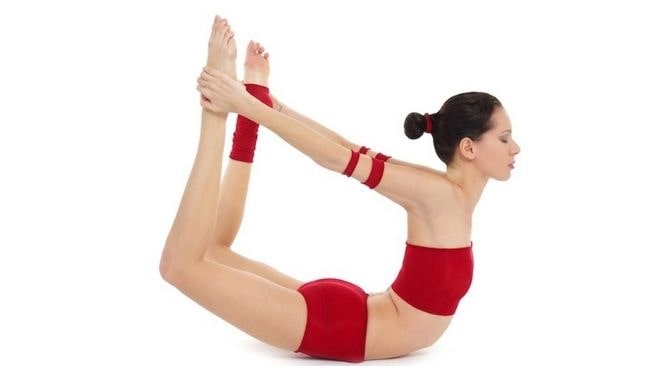Dhanurasana consists of two words “dhanur” and “asana” which means “bow” and “pose” respectively. The name Bow Pose is given because it resembles an archer’s bow with its string attached. The torso and thigh parts of the body represent the bow and the hands and legs represent the string.
It is a part of prone yoga poses and comes under the backbend poses that use the belly to balance the entire body. Dhanurasana provides an extension in the spine and limbs, and build core body strength.
How to Perform Dhanurasana?
The steps to perform Dhanurasana or Bow Pose are as follows:
- Lie flat on the floor on the stomach with face downwards. Keep your hands alongside your torso and legs slightly apart.
- Exhale and bend your knees and bring your heels near to the buttocks as far as possible.
- Now, stretch the arm back to hold the ankles or toes of your leg. Make sure the knees are hip-width apart.
- Inhale and lift your chest off the floor and simultaneously pulls the legs up by raising the knees above the ground.
- Lift up your head and pull it back as far as possible.
- Hold this position for 30 seconds to 1 minute and take long deep breaths.
- To release this pose, exhale and slowly bring your chest and legs back to the floor. Repeat the process for 2 to 3 rounds.
Benefits of Dhanurasana
Practicing Dhanurasana provides the following health benefits:
- It stretches and strengthens legs, neck, shoulder, and neck muscles.
- As performing Dhanurasana opens up the chest and strengthens the lungs, it can be beneficial in asthma or respiratory problems.
- It provides strength and flexibility to the spine.
- Improves posture.
- Dhanurasana helps to increase blood circulation in the spinal area.
- It is effective in providing relief from back pain.
- It helps to reduce weight around the abdominal area.
- Performing Dhanurasana is believed to help to get rid of gastrointestinal and menstrual disorders.
- This asana is helpful in relieving constipation.
- Good for diabetes.
Precautions
Do not practice Dhanurasana if you have following situations:
- High or low blood pressure.
- Headache or Migraine.
- Stomach ulcer or diarrhea.
- Insomnia.
- Heart ailments.
- Lower-back or neck injuries.
- Menstruating or pregnant.
Tips to Ensure Safety and Alignment on Dhanurasana
- Do not rest the ribs and/or the pelvic bones on the floor.
- While raising the legs do not hold them at the thighs.
- Do not hold your breath while performing Dhanurasana as it can result in head heaviness.
- To avoid direct load on the spine, keep the legs and arms firm.
- When you start lifting your legs with the hands, press your shoulders against the back.
Also Read:
- Pawanmuktasana: Steps, Benefits and Precautions
- Makarasana: Benefits, Steps and Precautions
- Anulom Vilom Pranayama : Benefits, Steps and Precautions

